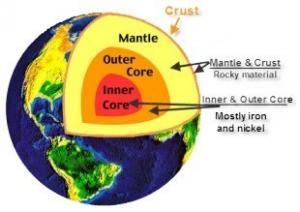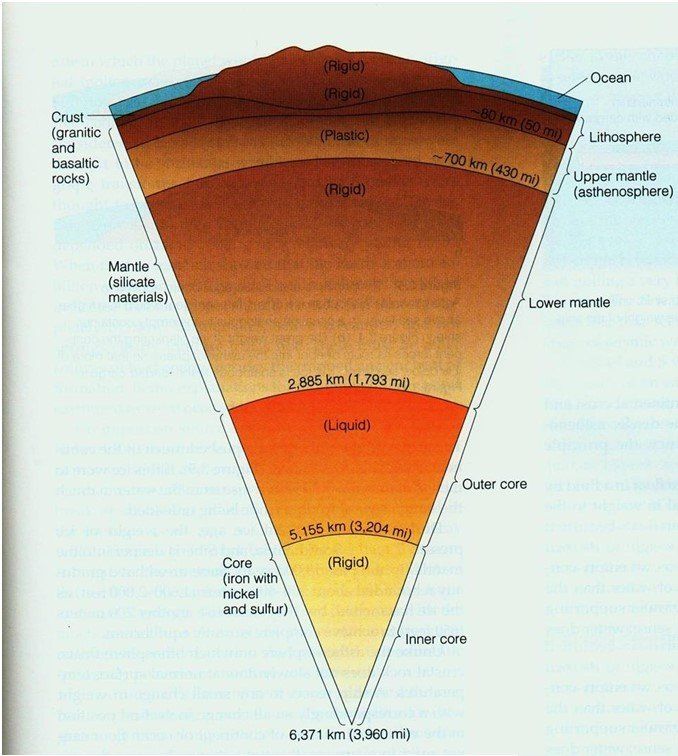Layers of the Earth
Grade 7 Science Worksheets
Earth’s Structure
What are the four different layers of the earth?
Geologists have observed vibrations (seismic waves) made by earthquakes to understand the structure of the earth’s inside. They found that it is divided into these distinct layers: the crust, the mantle , outer Core and the inner core.

Credit: https://sites.google.com/site/biologiaygeologiade1eso/home/2-la-tierra
Schedule a Free session to clear worksheet doubts
No credit card required, no obligation to purchase.
Just schedule a FREE Sessions to meet a tutor and get help on any topic you want!
Crust
Crust is the top or the outermost layer. It is very solid, and also the thinnest of all layers, only about 5000m thick under the oceans and about 30000m of thickness under the landmasses.
Mantle
It is made of two parts, upper and lower, the thick upper layer is made of extremely hot, semisolid liquid rock pattern and is located directly below the crust and is about 2,900 km thick.
Outer core
The outer core is the only layer which is a liquid layer: an ocean of mostly thoroughly liquid iron and nickel. It is about 1,800 to 3,000 miles below the surface and about 2,300 km thick.
Inner core
An extremely hot layer, solid ball of iron and nickel at the center of the earth. It is 3,000 to 3,960 miles below the surface and about 1,200 km in diameter.
Lithosphere
This layer is made up of the crust and a very small lining of the upper mantle; it is divided into many slowly moving plates of solid structure that has the continents and oceans above it.
Asthenosphere
The upper mantle makes the plates of the lithosphere move on this hot, liquid magma right below the lithosphere.
How deep are the layer of the earth?

Credit: https://flowvella.com/s/1boy/Travel-brochure?iframe=true
Plate Tectonics
German scientist Alfred Wegener was the first who found that the coastal length of Africa and South America seemed like a jigsaw puzzle that fit together. He also got proof of the same by studying and analyzing the plant and animal fossils along the coasts of these continents, even though now they were separated by vast oceans. He also noticed that physical formations, like mountain ranges, on the two continents also were same.
Later in the book, The Origin of Continents and Oceans, he described that the earth’s continents were once one large mass and called it the supercontinent Pangaea, meaning “all the earth”. Pangaea is believed to have split into different landmasses and continental pieces in geological time and now moved to its current locations on the planet.
Continents drifting
Around 200 million years ago
Pangaea breaks up into two major land masses. Laurasia in the north made up of North America and Eurasia andGondwana in the south.
Around 135 million years ago
Gondwana separates even more. South America and Africa drift from the Australian antarctican landmass
Some 65 million years ago
Laurasia separates from Eurasia and North America and then Africa is separated from South America and Madagascar as South America drifts away.
50-40 million years ago
Now Greenland moves away from North America and Australia floats northwards separating from Antarctica.
The modern plate tectonics theory, says that the earth’s outer layer, or lithosphere, is broken into several large pieces called plates.
These are tectonic plates, which hold the continents and oceans and are slowly but constantly moving on the Earth’s surface. The movement of the plates proves that the continents are not fixed and had moved over time, and also describes how and why earthquakes, volcanoes, and other events occur in Nature.
Learn more about Layers of the Earth and other important topics with 7th Grade Science Tutoring at eTutorWorld. Our expert science tutors break down the topics through interactive one-to-one sessions. We also offer the advantage of customized lesson plans, flexible schedules and convenience of learning from home.
Personalized Online Tutoring from eTutorWorld
eTutorWorld offers affordable one-on-one live tutoring over the web for Grades K-12, Test Prep help for Standardized tests like SCAT, CogAT, MAP, SSAT, SAT, ACT, ISEE and AP. You may schedule online tutoring lessons at your personal scheduled times, all with a Money-Back Guarantee. The first one-on-one online tutoring lesson is always FREE, no purchase obligation, no credit card required.
For answers/solutions to any question or to learn concepts, take a FREE TRIAL Session.
No credit card required, no obligation to purchase.
Just schedule a FREE Sessions to meet a tutor and get help on any topic you want!
Check Point
Explain the following:
- Crust
- Mantle
- Outer core
- Asthenosphere
- Lithosphere
Answer Key
- Crust: Crust is the top or the outermost layer. It is very solid, and also the thinnest of all layers, only about 5000m thick under the oceans and about 30000m of thickness under the landmasses.
- Mantle: It is made of two parts, upper and lower, the thick layer is made of extremely hot, semisolid rock is located directly below the crust and is about 1,800 miles (2,900 km) thick.
- Outer core: The outer core is the only layer which is a liquid layer: an ocean of mostly thoroughly liquid iron and nickel. It is about 1,800 to 3,000 miles below the surface and about 2,300 km thick.
- Asthenosphere: The upper mantle makes the plates of the lithosphere move on this hot, liquid magma right below the lithosphere
- Lithosphere: This layer is made up of the crust and a very small lining of the upper mantle; it is split into many slowly moving plates of solid structure that consists of the continents and oceans.
Learn more about Scientific Method and other important topics with 7th Grade Science Tutoring at eTutorWorld. Our expert science tutors break down the topics through interactive one-to-one sessions. We also offer the advantage of customized lesson plans, flexible schedules and convenience of learning from home.
Pricing for Online Tutoring
| Tutoring Package | Validity | Grade (1-12), College |
|---|---|---|
| 5 sessions | 1 Month | $124 |
| 1 session | 1 Month | $25 |
| 10 sessions | 3 months | $239 |
| 15 sessions | 3 months | $354 |
| 20 sessions | 4 months | $449 |
| 50 sessions | 6 months | $1049 |
| 100 sessions | 12 months | $2049 |
6th Grade Free Worksheets
- Elements & Compounds
- Solar Energy
- Photosynthesis
- Digestive System
- Electricity and Magnetism
- Law of conservation of energy
- Law of Conservation of Mass
- Periodic table
- Properties of Matter
- Waves
- Energy Resources
- Weather and Climate
- Immune, Circulatory and Digestive Systems
- Organs in Multi-cellular Organisms
- Sedimentary, Igneous, and Metamorphic Rocks
- Structure of the Earth
- Physical and Chemical Changes
- Scientific Method
- Cycles in Nature
- Environmental Science
- Renewable and Non-renewable energy Resources
- Characteristics of Living Organisms
- Life Science
- Earth and Space Science
- Solar Eclipse
- Heat Technology
- Newton’s Laws of Motions
- Physical Science
- Tools, Measurement and SI Units
- Earth Atmosphere
- Interactions of Living things
- The Earth Ecosystem
- Organelles in Plant and Animal cells
- Layers of the Earth


